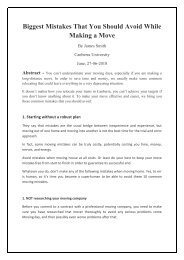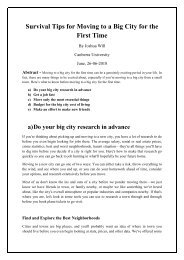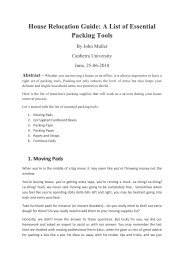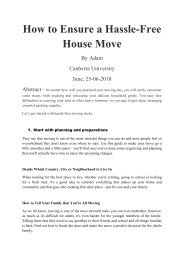What to do when moving out of a rental property tenant move out checklist
Create successful ePaper yourself
Turn your PDF publications into a flip-book with our unique Google optimized e-Paper software.
7. Sweep and vacuum your floors. You may wish <strong>to</strong> save cleaning your floors for last, since<br />
cleaning walls and other surfaces can create a mess on the floor. Once you are ready, wipe up<br />
any wet spots on the floors. Sweep hard floor surfaces clean with a broom and dustpan.<br />
Vacuum any carpeted surfaces.<br />
8. Mop your floors. Once you have swept, mop any hard floor surfaces with a traditional push<br />
mop or a steam mop. In areas that are especially prone <strong>to</strong> messy floors, like kitchens and<br />
bathrooms, you may wish <strong>to</strong> go over the floor more than once. Scrub any extra stubborn spots<br />
with a scrub brush and detergent.<br />
Take extra care <strong>when</strong> cleaning hardwood floors. Ask your landlord or <strong>property</strong> manager what<br />
type <strong>of</strong> finish is on your floor and get appropriate cleansers before attempting <strong>to</strong> clean it<br />
thoroughly.<br />
9. Clean your carpets. After vacuuming any carpeted surfaces, you may wish <strong>to</strong> spot clean or<br />
shampoo them. Purchase a carpet cleaning solution, like Resolve or Zep. Test it in a discreet<br />
area <strong>to</strong> make sure that it <strong>do</strong>es not damage, bleach, or stain your carpet. Spot clean with a<br />
clean, white rag. For cleaning larger areas, you can purchase or rent a carpet shampooer.<br />
Some landlords may prefer <strong>to</strong> bring in a pr<strong>of</strong>essional carpet cleaning service after their<br />
<strong>tenant</strong>s <strong>move</strong> <strong>out</strong>, so you should discuss this with your landlord before calling in anyone <strong>to</strong><br />
clean your carpet for you.<br />
Document the condition <strong>of</strong> the <strong>rental</strong> <strong>property</strong><br />
As a <strong>tenant</strong> you have rights under the Residential Tenancies Act 2010 and Residential<br />
Tenancies Regulation 2010. This factsheet <strong>out</strong>lines NSW residential tenancies law.<br />
<strong>What</strong> the Act means for <strong>tenant</strong>s<br />
Most residential tenancies in NSW are covered by the Residential Tenancies Act 2010<br />
(‘the Act’)<br />
The Act and the regulations set <strong>out</strong> a standard residential tenancy agreement that<br />
gives rights and obligations <strong>to</strong> landlords and <strong>tenant</strong>s.<br />
The Act gives the NSW Civil and Administrative Tribunal (NCAT) power <strong>to</strong> hear and<br />
settle disputes ab<strong>out</strong> residential tenancies, including bond disputes.<br />
Who the Act covers<br />
<br />
<br />
Private <strong>tenant</strong>s who have a written or oral residential tenancy agreement<br />
social housing <strong>tenant</strong>s, including <strong>tenant</strong>s <strong>of</strong> Housing NSW, community housing<br />
providers and the Aboriginal Housing Office. Social housing providers have certain<br />
specific rights and obligations under the Act







